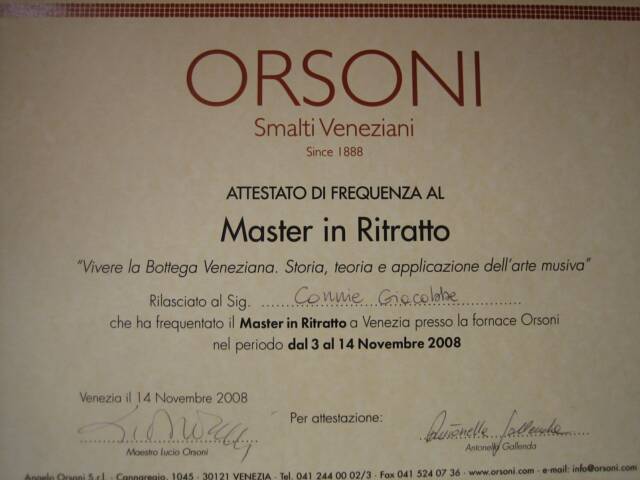 | ||||
 | ||||



 | ||||||
 | ||||||

 | ||||||
Classes In Italy
Love what you do...Do what you love

 | ||||||

Artist Statement of Work
Connie Giacobbe
Mosaic is the art of creating images with an assemblage of small pieces of colored glass, stone,
or other materials. It may be interior or exterior decorative art, or it may be of a cultural and/or
spiritual significance. Small pieces, normally cubic shaped are known as tesserae and are used
to create a pattern or a picture. You may find many ancient mosaics which are more
architectural. Modern mosaics can be found covering everything from park benches and
flowerpots to guitars and bicycles. Personally, I am an old school Italian trained Mosaicists. I
am classically trained so all Roman and or Byzantine mosaics with a little Micromosaic thrown in
for good measure is where my mosaic interest lay.
Early mosaics were made several thousand years ago. They were terracotta cones pushed
point first into walls and pillars for decorative purposes. Around the 8th century BC, pebbles
and stones of various colors were used to create patterns for pavements. The Greeks around
the 4th century brought the pebble technique to a whole new level of art form with geometric
patterns and scenes of animals and of people. By 200 BC glass started to be used to give
extra detail and a far greater range of color. This manufactured glass was and still is called
Smalti. Many Byzantine mosaics you see today are made with Smalti and gold backed glass.
Most Smalti was produced in and around Northern Italy. Roman Mosaic have stood the test of
time as they are made of stone or marble mainly used for flooring. In its raw state marble can
give a soft look to mosaics however, it can and is sometimes polished to produce an even larger
color palette.
The glass Smalti is my preferred product of choice. Sand, silica, and minerals combined, then
heated form the large glass patties, or as the Italians refer to them “Smalti Pizzas”. The Smalti
pizzas are cut into the individual cubic shaped tesserae. The Smalti are cut into tesserae using
a “Martellina” (hammer) and “Tagliolo”( chisel) again this is the way it is done today and how it
was done in the 2nd century. I think my love of the glass Smalti and the process of the ancient
techniques bring a circle of life kind of feeling for me. From the materials (Earth), from the
melting of those materials we get (Fire), the cooling down of the glass paste or annealing stage
we get (Air), and using the techniques of old we get the sweat of our brow (Water). OK, Ok I
agree maybe I can’t count the water element.

 | ||||||

 | ||||||

 | ||||||

 | ||||||

